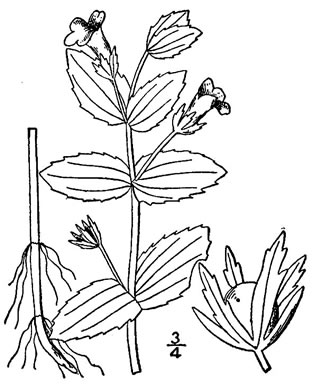Spermatophytes (seed plants): Angiosperms (flowering plants): Eudicots: Core Eudicots: Asterids: Lamiids: Lamiales
WEAKLEY'S FLORA OF THE SOUTHEASTERN US (4/14/23):
Gratiola viscidula
FAMILY
Plantaginaceae
Go to FSUS key
Dig deeper at SERNEC, a consortium of southeastern herbaria.
Read more about Viscid Hedge-hyssop at Vascular Plants of North Carolina.
SYNONYMOUS WITH
PLANTS NATIONAL DATABASE:
Gratiola viscidula
FAMILY
Scrophulariaceae
SYNONYMOUS WITH Floristic Synthesis of North America. BONAP (Kartesz, 2021)
Gratiola viscidula
SYNONYMOUS WITH Flora of North America north of Mexico, vol. 17 (2019)
Gratiola viscidula
SYNONYMOUS WITH Floristic Synthesis of North America (Kartesz, 1999)
Gratiola viscidula
SYNONYMOUS WITH Aquatic & Wetland Plants of Southeastern US (Godfrey & Wooten, 1979 & 1981)
Gratiola viscidula
SYNONYMOUS WITH VASCULAR FLORA OF THE CAROLINAS (Radford, Ahles, & Bell, 1968) 166-07-004:
Gratiola viscidula FAMILY Scrophulariaceae
SYNONYMOUS WITH Manual of the Southeastern Flora (Small, 1933, 1938)
Gratiola viscidula
COMMON NAME:
Viscid Hedge-hyssop, Sticky Hedge-hyssop, Short's Hedge-hyssop
To see larger pictures, click or hover over the thumbnails.
WEAKLEY'S FLORA OF THE SOUTHEASTERN US (4/14/23):
Gratiola viscidula
FAMILY
Plantaginaceae
SYNONYMOUS WITH
PLANTS NATIONAL DATABASE:
Gratiola viscidula
FAMILY
Scrophulariaceae
SYNONYMOUS WITH
Floristic Synthesis of North America. BONAP (Kartesz, 2021)
Gratiola viscidula
SYNONYMOUS WITH
Flora of North America north of Mexico, vol. 17
Gratiola viscidula
SYNONYMOUS WITH
Floristic Synthesis of North America (Kartesz, 1999)
Gratiola viscidula
SYNONYMOUS WITH
Aquatic & Wetland Plants of Southeastern US (Godfrey & Wooten, 1979 & 1981)
Gratiola viscidula
SYNONYMOUS WITH
VASCULAR FLORA OF THE CAROLINAS (Radford, Ahles, & Bell, 1968) 166-07-004:
Gratiola viscidula
FAMILY
Scrophulariaceae
SYNONYMOUS WITH
Manual of the Southeastern Flora (Small, 1933, 1938)
Gratiola viscidula
If a search such as "Carex leptalea var. leptalea" doesn't deliver the results you want, try "Carex leptalea".
Or, to minimize chances of a misspelling, try just "Carex le".
Less is more: If "pencil flower" doesn't deliver the results you want, try "pencil".


